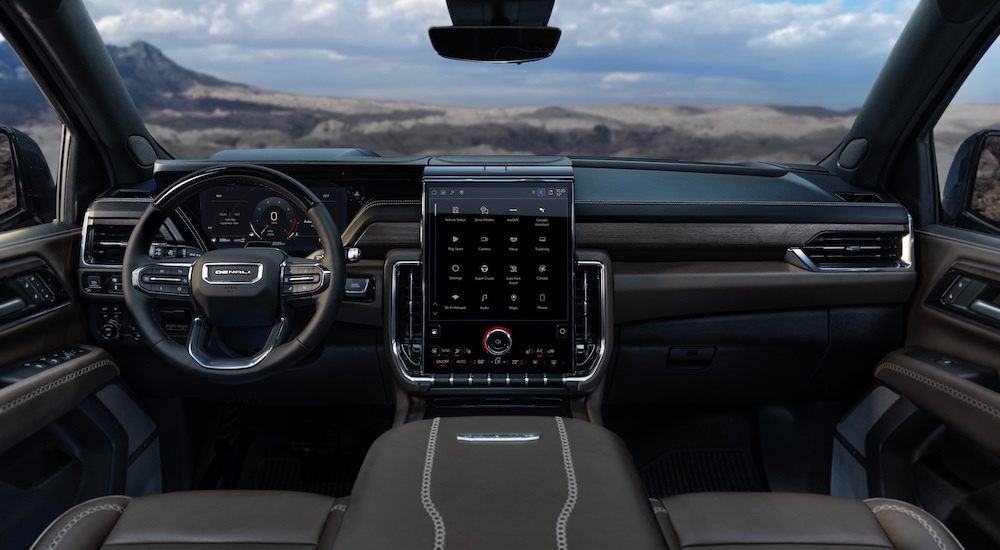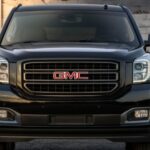If you’ve been browsing your local GMC dealer lately, you might have noticed that the automaker’s full-size SUV is looking a little different these days. That’s because the Yukon (along with its stretched-out variant, the Yukon XL) has received a major refresh for the 2025 model year. There are plenty of changes to cover, from tech upgrades to trim shake-ups to increases in power, so let’s dive in and see exactly what makes this Yukon different from its predecessor…
Exterior Design
The first thing you’ll notice about the new Yukon is its redesigned exterior. The new body looks more chiseled, projecting strength as loudly as it can. The front grille has a new slate of patterns to give each trim level a unique look. Headlamp and taillamp animations have also been added, giving the SUV a fun, flashy sense of futurism. Altogether, the Yukon definitely looks fresher but is still recognizably itself, with the chrome accents that visually differentiate GMC models from their Chevy counterparts and a front end that has the same basic layout as the one on the 2024 Yukon.
Interior Design
Step inside, and you’ll find exactly what you’d expect if you pay attention to recent automotive trends: more and bigger screens! While the 2024 model had a 10.2-inch screen oriented horizontally, the 2025 model has a 16.8-inch screen oriented vertically. You can use this digital real estate your own way, with a customizable layout of maps, audio settings, vehicle information, and more designed to let you put the features you prioritize at your fingertips. Move back to the rear of the cabin, and you might find the newly available 8-inch touchscreen that allows backseat passengers to adjust their climate control settings.

Trim Levels
The trim lineup is similar to what it was in 2024, but not exactly the same. The two entry-level trims on the 2024 model (the SLE and SLT) have been combined into a single trim, now called the Elevation. You can upgrade to the off-road AT4 or luxurious Denali, which are largely the same as they were last year, apart from the upgrades and changes that apply to the lineup as a whole. At the top of the trim list, the Denali Ultimate returns with some new tricks up its sleeve.
On the outside, the Denali Ultimate has large 24-inch wheels that are a first for the Yukon and are decorated with laser etching for a complex look. Its interior gets more than a bigger touchscreen; there’s also new open pore wood décor with laser-etched topographical patterns and a Bose audio system that now has up to 22 speakers (compared to the 18 speakers on the 2024 model), including stainless-steel ones that are built into the head restraints on the first row.
If you opt for the new Executive Seating option, those speakers will also be built into the headrests of the second row. This brings the comforts of the first row into the second, with heated and ventilated captain’s chairs that have a massage function. It also provides passengers with a pair of 8-inch touchscreens built into the backs of the front seat headrests.
New to the lineup is the AT4 Ultimate trim, which essentially blends the capability of the AT4 trim with the luxury of the Denali. Its four-corner adaptive air suspension works for both of these goals, adding up to two inches of additional ground clearance and providing a smoother ride over a variety of road surfaces, adjusting in real time to changing conditions. Inside, the cabin is decked out with full-grain leather and real wood accents, along with plenty of creature comforts.
Diesel Engine
The two gas-powered V8 engines are carrying over into the new model year essentially unchanged. The base 5.3L V8 still produces 355 hp and 383 lb-ft of torque and delivers 17 MPG combined, while the 6.2L V8 is an available upgrade for most trims (standard on the Denali) that delivers 420 hp, 460 lb-ft of torque, and 16 MPG combined. If you want to get out of the teens for fuel economy, you’ll want to upgrade to the diesel.
The diesel option is still a turbocharged 3.0L Duramax engine, but it’s been tuned to offer more power: 305 hp (up from 277) and 495 lb-ft of torque (up from 460). While official EPA figures for the new diesel haven’t been released at the time of this writing, it will likely remain similar to the 23 MPG combined it delivered for the 2024 model. Since it now has the best torque figure in the lineup, rather than merely being in a tie with the 6.2L V8, it makes sense that the diesel will now be available on the AT4 trims; that extra torque can come in handy on rough terrain, where activities like boulder crawling call for lots of power at low speeds.

Safety Features
Last but certainly not least, the Yukon’s suite of driver assistance tech has expanded, with new standard and available features designed to help drivers. In addition to features that should be quite familiar at this point, like automatic emergency braking and lane departure warning, you’ll now find front pedestrian and bicyclist braking, rear cross-traffic braking, side bicyclist alert, and intersection automatic emergency braking, which help the Yukon cover a wider range of situations you might find yourself in on the road, including more scenarios on city streets. On top of that, the Yukon is adding night vision, which uses heat sensing to let you see pedestrians and wildlife when it’s dark out.
Since the Yukon has a high towing capacity, the vehicle itself isn’t the only thing you have to keep in mind when considering safety. Since the extra weight and volume of a trailer can make driving extra risky, GMC has also introduced several new safety features that are specifically designed for towing:
- Blind Zone Steering Assist uses corrective steering to prevent potential accidents; the system monitors both the Yukon’s and the trailer’s blind zones.
- Transparent Trailer View requires you to add an auxiliary camera to the back of your trailer; it can let you “see through” your trailer for a clearer understanding of what’s behind you.
- Trailer Tire Health takes features that were already offered on the Yukon (like trailer tire pressure monitoring) and expands them into a system that also detects leaks, monitors the lifespan of your trailer’s tires, and gives you a warning if you’re going too fast.
- Jackknife Alert detects the position of your trailer in relation to the Yukon, giving you a warning if you’re in danger of jackknifing.
- Trailer Reverse Trajectory enhances the rearview camera by adding guiding lines that show you the path of your trailer, making it easy to maneuver and park.
Some Final Thoughts
Drivers interested in the top trims of the Yukon will probably be excited about the 2025 model. The new infotainment setup is fresh and modern, the executive second row is improved for those who want to make the backseat more comfortable for their passengers, and the new AT4 Ultimate trim is a superb option for those who want both off-road capability and luxury without compromising on either front.
Those on a budget looking for an entry-level option will be disappointed, however, since the new Elevation trim is going to have a significantly higher starting point than the outgoing SLE. So if you have the means to go all-out on a fancy Yukon, you’ll probably be a happy camper with a new model, but if you’re looking for a full-size SUV that doesn’t break the bank, it might not be a bad idea to consider a used model.



